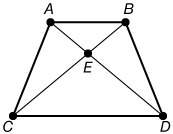
Mathematics, 29.10.2019 13:31, emm3456
Abdc is an isosceles trapezoid. given only the choices below, which properties would you use to prove acd ≅ bdc by sss?
the legs are congruent.
the base angles are congruent.
the bases are | |.
the diagonals are congruent.
(they all can be selected)


Answers: 3
Other questions on the subject: Mathematics


Mathematics, 21.06.2019 19:30, sweetbri7p5v6tn
Aline passes through 3,7 and 6,9 what equation represents the line
Answers: 2

Mathematics, 21.06.2019 21:40, joeykyle05
Write the contrapositive of the conditional statement. determine whether the contrapositive is true or false. if it is false, find a counterexample. a converse statement is formed by exchanging the hypothesis and conclusion of the conditional. a) a non-converse statement is not formed by exchanging the hypothesis and conclusion of the conditional. true b) a statement not formed by exchanging the hypothesis and conclusion of the conditional is a converse statement. false; an inverse statement is not formed by exchanging the hypothesis and conclusion of the conditional. c) a non-converse statement is formed by exchanging the hypothesis and conclusion of the conditional. false; an inverse statement is formed by negating both the hypothesis and conclusion of the conditional. d) a statement not formed by exchanging the hypothesis and conclusion of the conditional is not a converse statement. true
Answers: 1

Mathematics, 21.06.2019 21:50, amakayla57
What is the next step in the given proof? choose the most logical approach. a. statement: m 1 + m 2 + 2(m 3) = 180° reason: angle addition b. statement: m 1 + m 3 = m 2 + m 3 reason: transitive property of equality c. statement: m 1 = m 2 reason: subtraction property of equality d. statement: m 1 + m 2 = m 2 + m 3 reason: substitution property of equality e. statement: 2(m 1) = m 2 + m 3 reason: substitution property of equality
Answers: 3
Do you know the correct answer?
Abdc is an isosceles trapezoid. given only the choices below, which properties would you use to prov...
Questions in other subjects:


History, 05.05.2020 10:55

Biology, 05.05.2020 10:55






Geography, 05.05.2020 10:55


 and
and 
![\overline{CD}=\overline{CD}....[\text{reflexive property}]](/tpl/images/0351/1447/945dd.png)
![\overline{AC}=\overline{BD}..........[\text{ legs are congruent in isosceles trapezoid}]](/tpl/images/0351/1447/26bb7.png)
![\overline{AD}=\overline{BC}..........[\text{ diagonals are congruent in isosceles trapezoid}]](/tpl/images/0351/1447/be84c.png)
![\Rightarrow\triangle{ACD}=\triangle{BDC}........[\text{SSS congruence postulate}]](/tpl/images/0351/1447/d795e.png)




